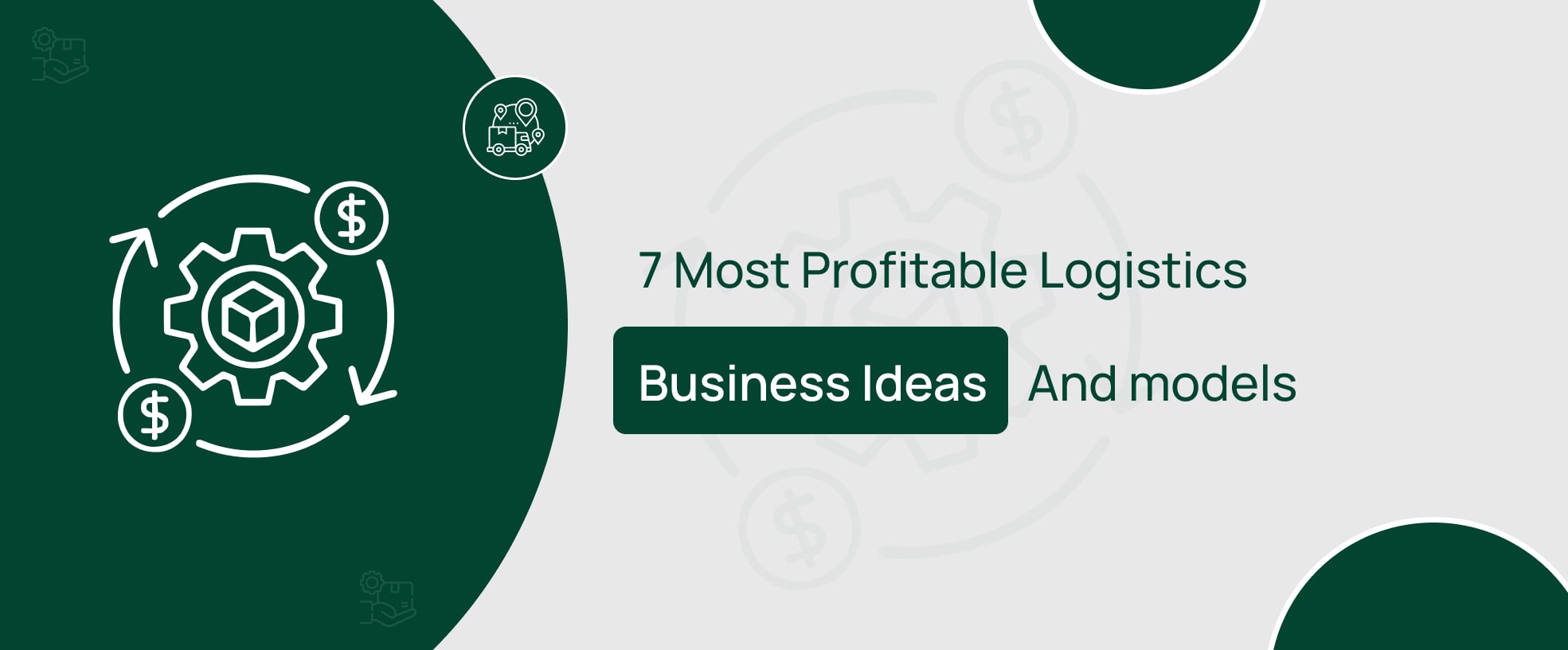7 Most Profitable Logistics Business Ideas And Models

People acknowledge that logistics is the backbone of e-commerce. It is not just the backbone but the lifeline through which profits flow. Are you ready to start shipping profits with these logistics business ideas that never fail? Dive in!
What is Logistics?
To put it simply, logistics is the process of monitoring and managing supplies. It tracks and streamlines the supply chain operations from when supplies enter the warehouse till they are finally shipped.
Logistics management promotes efficiency, reduces costs, and boosts productivity. Conversely, inadequate logistics leads to timely delivery failures, dissatisfied customers, and business losses. Thus, we will learn the top logistics business ideas below.
Smart businesses know how to stay ahead. Outsourcing logistics operations means running a business smoothly, efficiently, and profitably. Before delving into logistics business ideas in detail, here are a few key statistics to know:
Key Statistics and Facts To Know About Logistics
Whether you are an aspiring entrepreneur looking for bright logistics business ideas or an investor seeking profits, here are the key statistics to know:
- FedEx deploys EVs to advance sustainable goals of zero-emission last-mile deliveries in India. [1]
- Growing at a CAGR of 14.2, the global warehouse automation market size is expected to reach 30.69 billion by 2028. [2]
- E-commerce logistics is projected to grow at a Compound Annual Growth Rate of 22.3% from 2023 to 2030. [3]
Top 7 Future-Oriented Profitable Logistics Business Models and Ideas
Here are the top logistics business ideas to reap continual benefits:
#1 – Automated Warehousing & Fulfillment Centers:
Investment in smart warehouse technologies, such as automated and AI-powered warehouses with robotic arms, can ease several repetitive tasks, leading to efficiency. This smart warehousing service can meet customers’ rising demands and lead to faster order fulfillment.
The automation process optimizes warehouse space. IoT sensors lead to highly accurate, real-time inventory tracking and monitoring. Automation of several warehouse tasks leads to faster order fulfillment and happy customers.
What to do?
Setting up an automated warehouse and fulfillment center requires a minimal capital investment of $50,000. You need to assess your needs, choose a suitable location, and select the best automation technology, such as a retrieval system, Conveyor Belts, Automated Storage, etc. After that, you must train the staff to use the automated process.
#2 – EVs & Drones For Last-Mile Deliveries:
Last-mile deliveries are the final stage of the supply chain when goods are delivered to the customers. Providing local delivery services with drones and electric vehicles increases efficiency. Additionally, implementing AI-driven processes to optimize routes saves fuel costs and minimizes delivery times.
This logistics business model is profitable in several ways. Consumers receive faster and more convenient deliveries, increasing their satisfaction rate. Drones and electric vehicles are also eco-friendly options. The model is sustainable and saves the environment.
What to do?
Delivering supplies from the manufacturing units to the end customers does not require huge capital. But it does require the right strategy. Optimizing the routes, knowing the key performance indicators, etc., are the basic things you need.
#3 – Blockchain-Based Supply Chain Management:
Blockchain technology uses a decentralized ledger for supply chain management. This future-oriented logistics business idea has the biggest advantage of not involving financial institutions to verify transactions. Blockchain technology is encrypted and publicly accessible to everyone in the supply chain if the participants are using the technology.
Blockchain technology offers many benefits: increased security, real-time monitoring, better data sharing, stability, high profitability, and complete customer satisfaction. Smart contracts help automate the payment process and track regulatory compliance, reducing fraud and inefficiencies. Additionally, it integrates well with technologies like IoT and AI.
What to do?
To embrace this logistics business idea, you must identify the key stakeholders in the supply chain. After selecting the right blockchain platform, you require a system for digitally tagging products. Blockchain integration demands robust security measures and a significant capital investment.
#4 – AI-Powered Freight Brokerage:
AI-powered chatbots and virtual assistants provide round-the-clock customer support and can track shipments in real time, greatly enhancing customer satisfaction. They use the latest artificial intelligence algorithms to match shippers with available carriers, resulting in optimized freight.
Also, with AI freight management, businesses can monitor and manage transportation in real time. Traditional freight brokerage services are fraught with inefficiencies. With an advanced level of AI, transportation costs can be greatly reduced. AI enables the freight forwarders to handle a very large volume of data quickly with accuracy.
What to do?
To start using AI in freight brokerage and reap all its benefits, you must integrate a robust WMS with an AI-enabled freight brokerage feature. The cloud-based deployment model would cost somewhere between $ 100-$ 500 per user/month.
#5 – Cold Chain Logistics For Weather Sensitive Supplies:
Perishable goods like food and pharmaceuticals need to be handled with care. IoT-based monitoring for weather-sensitive shipments maintains the quality and integrity of goods.
Using predictive insights from AI data analytics helps in real-time tracking of items and addresses issues before they grow. IoT monitors temperature, humidity, etc., for the safety of perishable items. Blockchain provides complete transparency and traceability of supplies.
Apart from that, refrigerated vehicles with temperature-controlled compartments ease the transportation process. Demand for weather-sensitive supplies is rising, so this logistics business model is in high demand.
Efficient transport solutions, such as refrigerated trucks and insulated containers, ensure products are consistently kept at the appropriate temperature during transit. Quality Control: Regular audits and quality checks at different stages of the supply chain validate that all specifications are met.
What to do?
To start a food or pharmaceutical business, you must invest in cold chain logistics. This method also saves perishable items. Refrigeration units and temperature monitoring systems cost a few hundred thousand dollars for a small enterprise.
#6 – On-Demand Warehousing & Micro-Fulfillment Centers
Seasonal or fluctuating inventory is one of the major challenges for the warehouse. Meeting seasonal or fluctuating inventory is difficult when demand is at its peak.
Utilizing cloud-based inventory for seamless coordination helps. Besides, setting up micro-fulfillment centers in big cities assists in efficient and timely delivery. This meets the expectations of same-day delivery and leads to high customer satisfaction.
What to do?
Invest in a robust WMS to manage and track inventory, optimize warehouse space usage, automate repetitive tasks, etc. First of all, you need to locate the centers strategically near the urban areas for faster deliveries and partner with dependable 3PLs for better efficiency
#7 – AI-Enabled Predictive Logistics & Demand Forecasting
Artificial Intelligence analyzes a vast data pool. It can also locate the external factors affecting the demand, resulting in an accurate demand forecast and optimized inventory. This streamlines inventory management and reduces waste.
Advanced analytics and the integration of IoT devices help in the real-time shipment of supplies and their optimization. AI-driven useful insights help businesses gain a competitive edge in planning, monitoring, and management.
What to do?
Certain groundwork needs to be done to adopt this logistic business model. You need to collect and integrate data from different sources and select the accurate AI algorithms to fulfill your requirements.
Key Factors To Consider While Selecting A Logistics Business Model
Choosing the right logistics business model requires careful consideration of various factors to ensure efficiency, scalability, and profitability. Here are the key factors to consider:
Business Strategy and Its Goals:
Your business needs to consider its short-term and long-term goals. Check whether your adopted logistics model aligns with your business needs and strategies.
Understand The Market Needs And Your Industry:
Choose the logistics business model that fits your industry’s needs. Evaluate market trends at global and regional levels. Determine what type of services customers are looking for, etc.
Scalability & Flexibility:
Choose a model that is scalable to your business’s changing needs. This model can easily adapt to the market’s changing needs and can meet fluctuations in demand.
Different Types of Logistics Models:
There are different types of logistics models, for instance:
Budget and Financial Viability:
Consider your budget. Fixed costs can be higher than variable costs. You also need to make initial capital investments and meet operational expenses.
There are other factors to consider as well. Check out:
Practical Tips for a Successful Logistics Business
Running a logistics business profitably without a strategy can be daunting. Here are a few useful tips.
Tip #1 – Analyze The Market Trends and Demands:
You must evaluate the market carefully and be aware of the latest consumer trends. Conducting thorough research will help you understand the demand for logistics services. Also, it is important to identify existing gaps and customer pain points so that necessary action can be taken.
Tip #2 – Prepare a Complete Plan:
Once you finish your market research, you must develop a comprehensive business model. It should include an outline of the business plan, strategies, and the capital in hand, etc.
Tip #3 – Fulfill The Regulatory Compliance and Legal Requirements:
You will need to obtain the necessary licenses and permits. You need to ensure compliance with the tax laws, labor laws, custom regulations, etc.
Tip #4 – Embrace Technology and Automation:
To manage the supply chain maximally, you should use the latest AI-driven tools and technologies, including IoT-based real-time tracking methodologies.
Tip #5 – Scalability and Customization:
The technology you choose should offer all the robust functionalities and be scalable to handle your business’s growing needs.
Common Mistakes To Avoid That Businesses Make In Logistics:
These are the commonly made mistakes that you need to avoid.
Final Thoughts:
The logistics industry is profitable, provided you have the right approach and ideas. This sector is experiencing rapid transformation. Good logistics business ideas, such as on-demand deliveries, warehousing, safety regulatory compliance, etc., can help you earn high profits.
Key Takeaways:
Know Before You Go!
Here are the answers to some of your top queries!
1. Which logistics business is the most profitable?
All logistics businesses are profitable depending on how they are handled. The most profitable ones are:
- 1. Warehousing and storage solutions
- 2. Freight forwarding
- 3. Supply chain management
- 4. Cross-border logistics
- 5. E-commerce logistics
2. How to run a successful logistics business?
To run a successful logistics business, you need comprehensive business planning, thorough market research, an understanding of industry regulations, and secure permits, licenses, etc. Adopting smart technologies that can optimize cost and increase efficiency is also essential.
3. Is the logistics business model bigger than the supply chain?
No, the supply chain is much bigger than logistics businesses. Logistics is just a component of the supply chain, which means the entire production and distribution network. Logistics just includes transportation, warehousing, the delivery process, etc.
4. How much capital is required to start a logistics business company?
The capital needed to start a logistics company depends on the type of business model you have. Typically, the capital investment ranges between $15,000 and $20,000.
5. What are the two major operations of a logistics business?
The two major operations in logistics are inbound logistics (the supply of raw materials) and outbound logistics (the distribution of finished supplies).
Leaks In Logistics Workflow? Stop Guessing And Start Growing With Us!
Your logistics operation is a storehouse of profits. You only need to open it with the correct key. Pick the right logistic business ideas and pave your path to continual success. We have crafted many success stories; now it’s your time to have one.
Contact us today!

